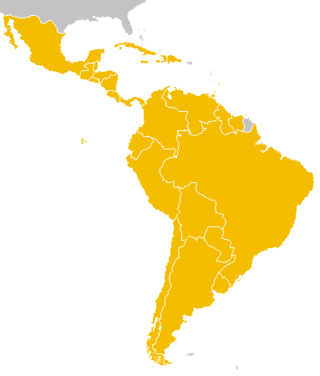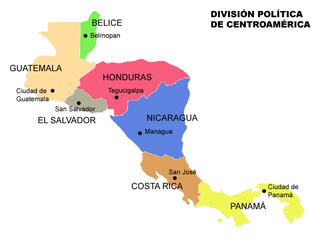
Central America is a subregion of the Americas. Its political boundaries are defined as bordering Mexico to the north, Colombia to the south, the Caribbean Sea to the east, and the Pacific Ocean to the west. Central America is usually defined as consisting of seven countries: Belize, Costa Rica, El Salvador, Guatemala, Honduras, Nicaragua, and Panama. Within Central America is the Mesoamerican biodiversity hotspot, which extends from northern Guatemala to central Panama. Due to the presence of several active geologic faults and the Central America Volcanic Arc, there is a high amount of seismic activity in the region, such as volcanic eruptions and earthquakes, which has resulted in death, injury, and property damage.

Central America is commonly said to include Guatemala, Belize, El Salvador, Honduras, Nicaragua, Costa Rica, and Panama. This definition matches modern political borders. Central America begins geographically in Mexico, at the Isthmus of Tehuantepec, Mexico's narrowest point, and the former country of Yucatán (1841–1848) was part of Central America. At the other end, before its independence in 1903 Panama was part of South America, as it was a Department of Colombia. At times Belize, a British colony until 1981, where English instead of Spanish is spoken, and where the population is primarily of African origin, has been considered not part of (Spanish-speaking) Central America.

The Federal Republic of Central America was a sovereign state in Central America which existed from 1823 to 1841. Originally known as the United Provinces of Central America, the democratic republic was composed of the territories of the former Captaincy General of Guatemala of New Spain.

The Rio Group (G-Rio) was a permanent association of political consultation of Latin America and Caribbean countries, created in Rio de Janeiro, Brazil on December 18, 1986 with the purpose of creating a better political relationship among the countries. It was succeeded in 2011 by the Community of Latin American and Caribbean States.

The Latin American Parliament (Parlatino) is a regional, permanent organization composed by the countries of Latin America and the Caribbean. It is a consultative assembly similar to the early European Parliament. Currently the institution is being considered to become the legislative organ of the Community of Latin American and Caribbean States.

The Latin American and the Caribbean Economic System, officially known as Sistema Económico Latinoamericano y del Caribe (SELA), is an organization founded in 1975 to promote economic cooperation and social development between Latin American and the Caribbean countries. In the early 1990s, its representatives consisted of members from 28 countries and took part in the General Agreement on Tariffs and Trade (GATT) negotiations, which led to a new global agreement on restrictions on trade and established the World Trade Organization (WTO).

SIEPAC is an interconnection of the power grids of six Central American nations. The project was discussed since 1987. The constructed new transmission lines connect 37 million consumers in Panama, Costa Rica, Honduras, Nicaragua, El Salvador, and Guatemala. It was expected to be completed in April 2013, and was completed in 2014. There is controversy about the benefits and indirect environmental impacts of the project.

Central America is a subregion of the Americas formed by six Latin American countries and one (officially) Anglo-American country, Belize. As an isthmus it connects South America with the remainder of mainland North America, and comprises the following countries : Belize, Guatemala, Honduras, El Salvador, Nicaragua, Costa Rica, and Panama.
The Central America bioregion is a biogeographic region comprising southern Mexico and Central America.

The Central American Integration System has been the economic and political organization of Central American states since 1 February 1993. On 13 December 1991, the ODECA countries signed the Protocol of Tegucigalpa, extending earlier cooperation for regional peace, political freedom, democracy and economic development. SICA's General Secretariat is in El Salvador.

Harry Emil Brautigam was a Nicaraguan economist, banker and academic.
The Multilateral Investment Fund (MIF) is an independent fund administered by the Inter-American Development Bank (IDB), created in 1993 to support private sector development in Latin America and the Caribbean. In partnership with business organizations, governments, and non-governmental organizations (NGOs), MIF's stated goal is to provide technical assistance and investments to support micro and small business growth, build worker skills, and to improve markets and access to finance.

The UNCAF Nations Cup 2009 was the tenth edition of the UNCAF Nations Cup, the biennial football (soccer) tournament for the CONCACAF-affiliated national teams of Central America. The first five places qualified for the 2009 CONCACAF Gold Cup. The event was going to take place in Panama City, Panama between January 22 and February 1, 2009, but the Panamanian FA announced that they would not host the event due to not having an adequate stadium available for the time period of the tournament. The alternative hosts were Honduras and Guatemala. Honduras submitted an official replacement bid on November 12, and after some consideration it was moved to Honduras. All games were played in Estadio Tiburcio Carías Andino in Tegucigalpa. The tournament was sponsored by Digicel. On 1 February 2009 Panama won the tournament, the first UNCAF Nations Cup win in the country's history.

CAF - development bank of Latin America and the Caribbean, formerly the Andean Development Corporation, is a development bank whose mission is to promote sustainable development and regional integration in Latin America and the Caribbean, through the financing of projects of the public and private sectors, the provision of technical cooperation and other specialized services.

This is an index of Central America-related articles. This index defines Central America as the seven nations of Belize, Costa Rica, El Salvador, Guatemala, Honduras, Nicaragua, and Panama.

The 25th Central American Championships in Athletics were held at the Estadio Olímpico Palacio de los Deportes UNAH in Tegucigalpa, Honduras, between June 20–22, 2014.

The economy of Central America is the eleventh-largest economy in Latin America, behind Brazil, Mexico, Argentina and Colombia. According to the World Bank, the nominal GDP of Central America reached 204 billion US dollar in 2010, as recovery from the crisis of 2009, where gross domestic product (GDP) suffered a decline to 3.8%. The major economic sectors are agriculture and tourism, although the industrial sector has shown strong growth, mainly in Panama.
Dante Mossi Reyes is a Honduran economist, international civil servant and diplomat, who has since 1 December 2018, served as the Executive President of the Central American Bank for Economic Integration (CABEI). Prior to this chief executive role, he worked at the World Bank for many years in a variety of senior roles.

Central American reunification, sometimes called Central Americanism, is the proposed political union of the countries of Central America, which had historically occurred during the existence of the Federal Republic of Central America. It is distinct from the Central American integration process, which is a diplomatic initiative similar to that of the European Union.

The following lists events that happened during 2020 in Central America: Belize, Costa Rica, El Salvador, Guatemala, Honduras, Nicaragua, and Panama.


















